Every year, the emergency management community recognizes September as National Preparedness Month. And, every year, BOLDplanning pauses to remind everyone of a few simple, but oftentimes overlooked, measures that can make a world of difference in emergency situations. This couldn’t ring more true than now, in 2020, as our nation is faced with a number of unusual, not to mention simultaneous, events—the COVID-19 pandemic, deadly wildfires, back-to back hurricanes, and unfortunately, widespread civil unrest.
As mentioned in previous blog posts, week one of National Preparedness Month 2020 focused on the need to “make a plan,” and week two stressed the need to “build a kit.” Week three, which just ended on September 19th, emphasized the need to “prepare for disasters,” and just as importantly, to practice those plans and preparations on a regular basis.
Week four of National Preparedness Month is now underway, and will conclude on Friday, September 25, 2020. Its focus is “teach youth about preparedness,” and it couldn’t come at a better time as millions of students return to the classroom across the country. According to FEMA, emergency managers, teachers, and others who work with children understand that children and youth are an important part of our communities and can be vulnerable during disasters.
It’s important to ensure their protection, and to incorporate their needs in the planning, response, and recovery efforts of your community. This includes knowing how you will re-establish your facilities, such as schools, and essential services, such as public health, if impacted by a disaster, natural or otherwise.
“Children and youth are empowered through understanding risks and knowing how to protect themselves,” says FEMA’s Ready.gov campaign, and “empowered youth can help involve their families, peers, and communities in disaster preparedness.”
So, while National Preparedness Month 2020 may be coming to a close, the need to make a plan, build a kit, prepare for disasters, and teach youth about preparedness must continue in the months (and years) ahead. Do your part to keep the momentum (and the mentoring) going and everyone safe in these unprecedented times. Your work today just may influence the emergency management community of tomorrow.






